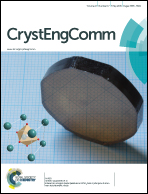Mixed-metal–organic frameworks (M′MOFs) from 1D to 3D based on the “organic” connectivity and the inorganic connectivity: syntheses, structures and magnetic properties†
Abstract
Based on the InOm notion (In = the dimensionality of the inorganic connectivity; Om = the dimensionality of the organic connectivity; n + m ≤ 3), we obtained ten transition/alkaline earth mixed-metal–organic frameworks (M′MOFs) from 1D to 3D through a “metalloligand” strategy at room temperature. Single-crystal X-ray diffraction analyses indicate that the resulting compounds possess the square plane [MII(pzdc)2]2− (M = Co, Ni or Cu) “organic” connectivity and the Ae–O–Ae (Ae = Ca, Sr or Ba) inorganic connectivity, which can be classified as I1O0 connectivity for complexes 1, 4, 7 and 9, I1O1 connectivity for complexes 2, 3, 5, 6 and 8 and I1O2 connectivity for complex 10. The [MII(pzdc)2]2− moieties acting as bis(tetradentate) polycarboxylate ligands show three types of coordination modes, namely μ4-(η2-O,O)2,(η1-O′)2, μ6-(η2-O,O)2,(η1-O′)2,(η1-O′)2 and μ10-(η2-O,O)2,(η2-O′,O′)2, (η1-O′)2,(η1-O′)2,(η1-N′)2. Additionally, the thermal stabilities of complexes 1–10 and magnetic properties of complexes 1, 2, 4, 5 and 10 have also been investigated.


 Please wait while we load your content...
Please wait while we load your content...